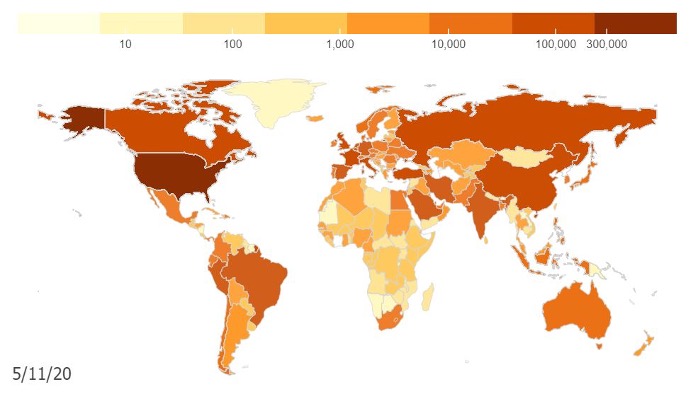Current situation and State COVID-19 Data by Race in the U.S.
Author: May Thongthum

As of May 16th, 2020, the total number of COVID-19 confirmed cases has surpassed 4.5 million, with the global death rate exceeding 300,000. The total confirmed cases in the U.S. alone have reached 1.4 million, followed by 260,000 in Russia, 238,000 in in the UK, 230,000 in Spain, 223,000in Italy and 220,00 in Brazil respectively. Additionally, the U.S. states have released COVID-19 data by race, broken down into three critical categories: confirmed cases, deaths, and testing. Dr. Lisa A. Cooper* reveals that access to race data on the development and implementation of the pandemic response could help local, state, and national policymakers identify which populations may need additional access to resources (testing/equipment/education) and support to implement physical distancing practices.
The data with key demographic characteristics e.g., race, ethnicity, and social class help policymakers and other decision-makers to better understand and determine which factors -at the level of individuals, families, neighborhoods, organizations, communities, and local, regional, and national policies- could be contributing to poor health across the country. Importantly, the data help policymakers decide how best to intervene on all these levels to remove barriers and ensure health equity among all citizens. For more information, please refer to the full article here
One finding reveals that SARS-CoV-2 that was grown in the plasma from a recovered patient (containing SARA-CoV-2 antibodies) developed mutations in one important section of the protein (the N-terminal domain) that allowed the newly formed variant to become completely resistant to the immunity induced by the vaccines. The mutations occur in a specific region of the virus that could be recognized by a sequence targeted immune response (presumably antibodies produced by B cells).
However, the human body also has T cell immunity that recognizes a full length of the spike protein, which is more difficult to not be recognized, in contrast to B cells that recognize a specific region of the virus. Although the degree to which T cells contribute to protection against SARS-CoV-2 remains unclear, the nature of the T cell response may suggest a limited effect of viral mutations on cellular immunity (Williams &Burgers, 2021). The article by Williams and Burgers presents an insightful discussion about SARS-CoV-2 evolution and vaccines. We highly recommend reading the article to learn more about this pressing issue.
References: